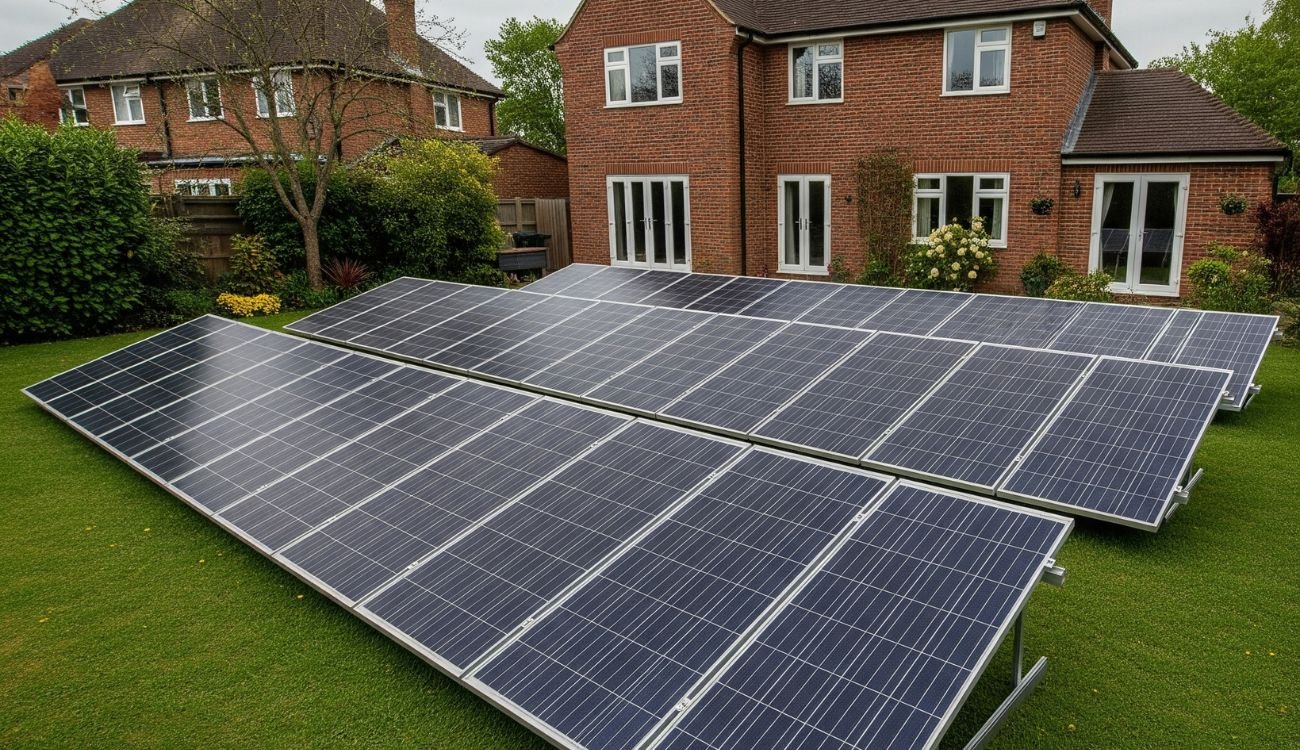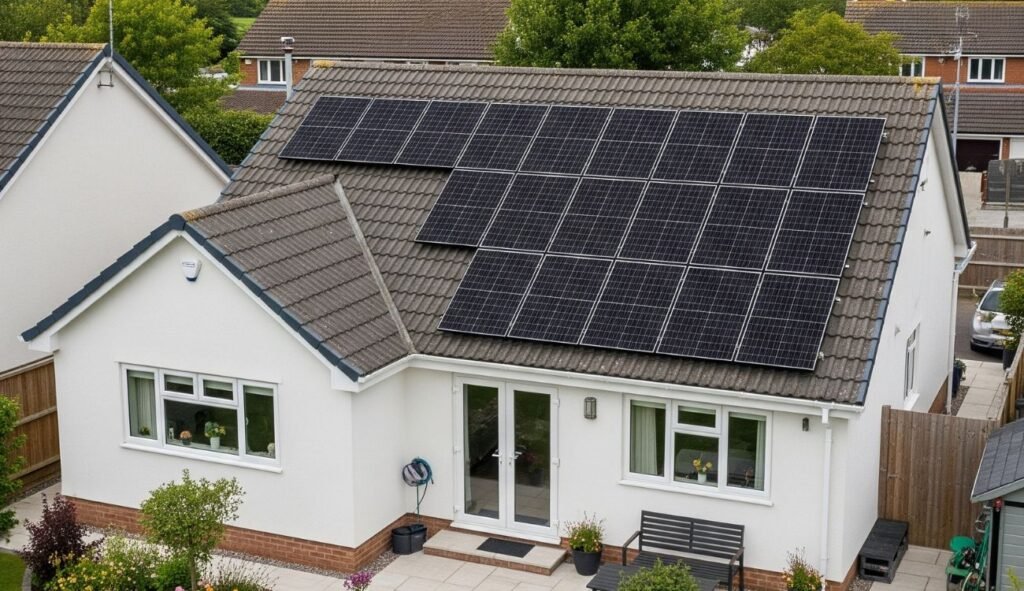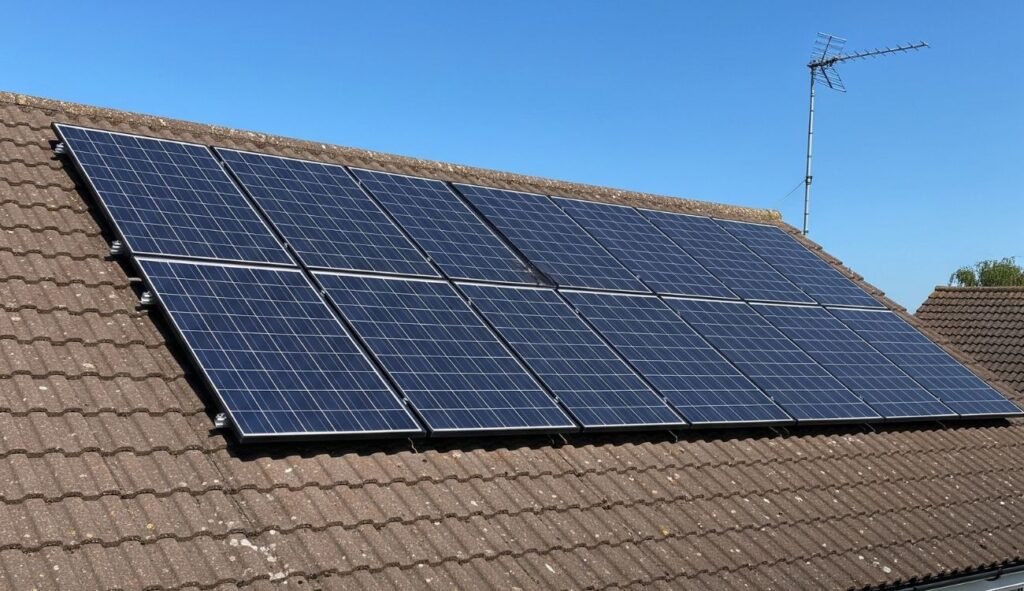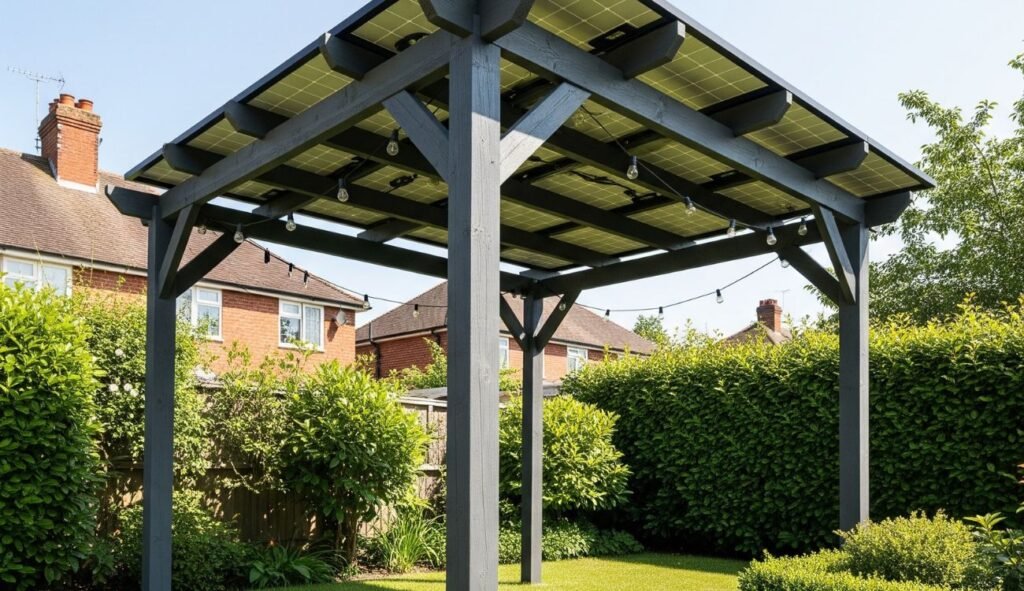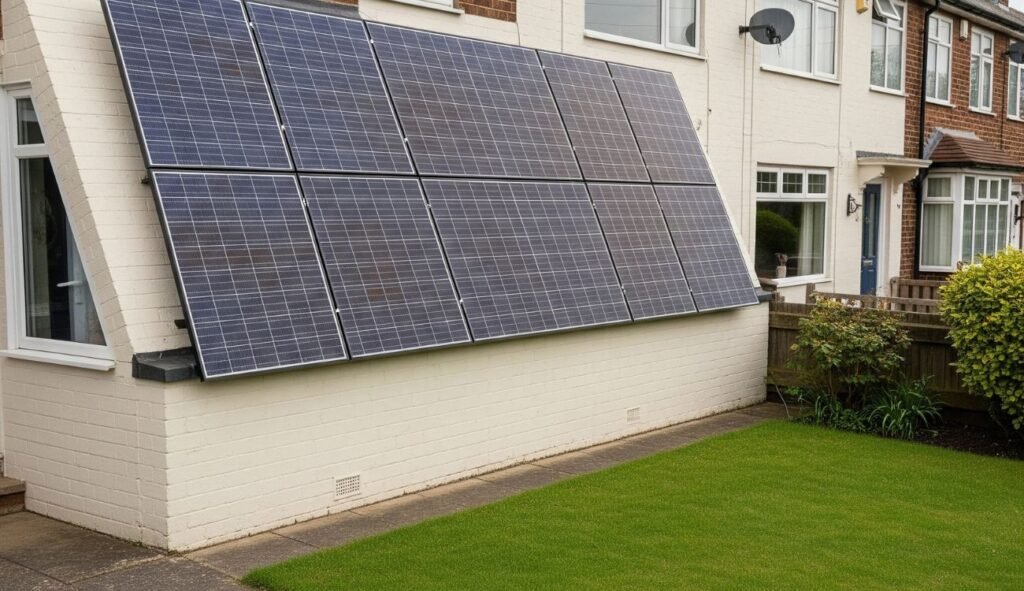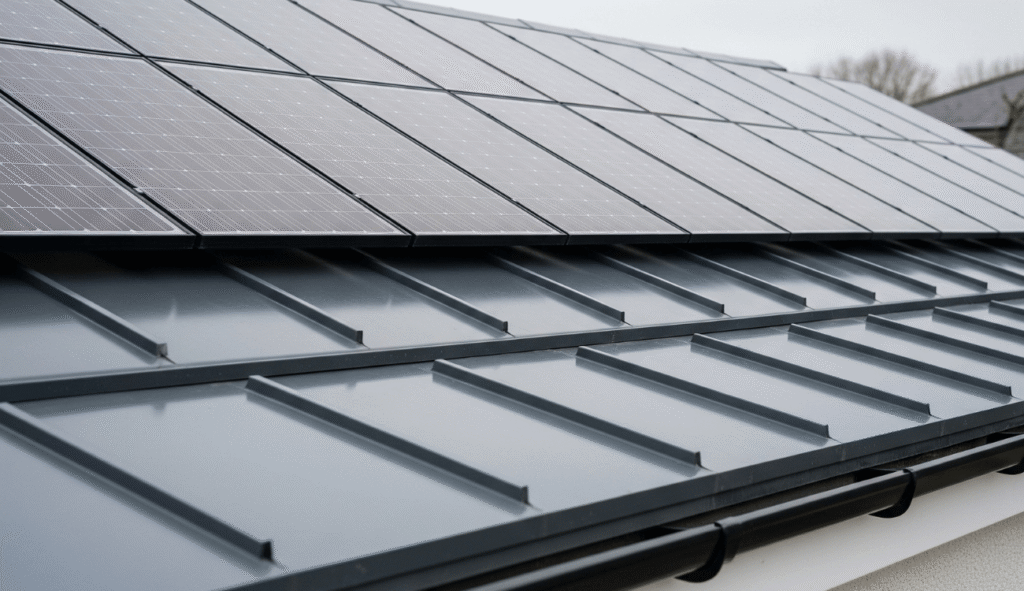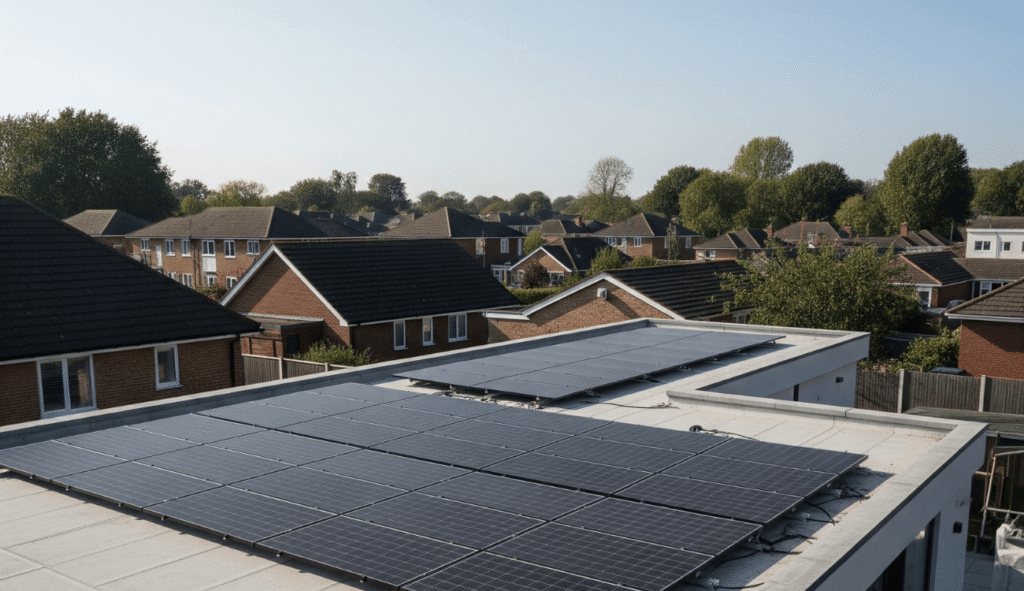As solar energy adoption continues to rise across the UK, more homeowners and commercial property owners are exploring ground mounted solar panels as a viable alternative to traditional roof-mounted systems.
Whether you lack suitable roof space or want to maximise solar yield, ground mounted systems offer flexible and efficient solutions.
In this guide, we’ll explore what ground mounted solar panels are, their benefits, installation considerations, and available UK grants.
What Are Ground Mounted Solar Panels?
Ground mounted solar panels are photovoltaic (PV) systems installed on open land using a frame or racking system, rather than being fixed to a roof.
These installations are secured into the ground using metal poles, screw piles, or concrete foundations, allowing the panels to be optimally tilted and oriented to maximise sunlight capture.
How do ground mounted solar panels work?
They function just like rooftop PV systems:
- Solar cells within the panels absorb sunlight and convert it into direct current (DC) electricity.
- An inverter then transforms the DC electricity into alternating current (AC), which can be used in the home or business.
- Excess electricity can either be stored in batteries or exported to the National Grid, earning you money under the Smart Export Guarantee (SEG).
The key difference lies in the placement of the system ground mounted setups are custom-positioned for optimal efficiency, often achieving higher generation than roof installations.
Types of ground mounted systems:
- Standard fixed-mount systems: Panels are installed at a set angle.
- Pole-mounted systems: Single or dual-axis tracking systems that follow the sun’s path for increased output.
- Solar farms: Large-scale arrays used for commercial and agricultural energy generation.
Pros and cons of ground mounted solar panels
Pros of Ground Mounted Solar Panels
- Maximum efficiency: Panels can be angled and oriented to the sun’s position year-round.
- No roof constraints: Ideal for properties with small, shaded, or awkwardly shaped roofs.
- Scalability: Easier to expand as energy needs grow.
- Cooling airflow: Enhanced performance due to better air circulation around the panels.
- Easier maintenance: Accessible height makes inspection and cleaning safer and more convenient.
Cons of Ground Mounted Solar Panels
- Requires sufficient outdoor space: Not suitable for small gardens or urban environments.
- Planning permission may be needed: Especially in conservation areas or listed properties.
- Higher upfront installation costs: Due to groundwork and mounting structures.
- Potential aesthetic concerns: Panels can be more visually intrusive in landscaped settings.
Ground mounted systems are particularly beneficial for rural homes, farms, commercial premises, and landlords with land availability.
In the North East of England, where property plots often offer more outdoor space, these systems provide a practical alternative to roof-based solar.
How Much Land Do You Need for Ground Mounted Solar Panels?
The space required depends on the system size. As a rough guide:
- 4kW system (suitable for an average household): Needs around 25-30 m²
- 10kW+ systems (ideal for commercial use): Require 60-80 m² or more. According to the Energy Saving Trust, a typical 4kW PV system can save households up to £520 per year on electricity bills. With optimised placement, ground mounted systems can yield even greater returns.
Considerations include:
- Shading from nearby trees or buildings
- Orientation to maximise sun exposure
- Access and cabling to connect to the main property
If you’re unsure whether your property is suitable, Future Heat offers site assessments across the North East to evaluate ground conditions, layout, and system viability.
How Are Ground Mounted Solar Panels Installed?
Installation involves several key steps:
- Site Survey – Assess land suitability, shading, and electrical connections
- Design & Planning – Panel layout, angle, and direction
- Foundation Work – Usually steel poles driven into the ground or concrete pads
- Panel Mounting – Fixed or tracking systems depending on budget and needs
- Grid Connection – Electrical hookup and inverter installation
- Commissioning – Testing and documentation for SEG eligibility
Installation typically takes 2–5 days depending on the system size and site conditions.
What Are the Costs of Ground Mounted Solar Panels?
The cost of ground mounted solar panels in the UK varies based on several factors, including system size, type of mounting (fixed vs. tracking), ground conditions, location, and labour charges.
On average, ground mounted systems are more expensive than roof-mounted ones due to the added complexity of groundwork and structural supports. However, they can also offer greater long-term value thanks to improved efficiency and easier maintenance.
Factors affecting cost:
- System size (kW capacity)
- Mounting type: Fixed frame or solar tracking systems
- Ground preparation: Soil condition, levelling, and anchoring
- Distance from the main property: Longer cabling and trenching may increase cost
- Labour and installer rates: Varies across UK regions
- Battery storage: Optional but adds cost if integrated
While prices fluctuate slightly depending on your installer and location, here’s a general breakdown of typical system costs:
Estimated Cost Table for Ground Mounted Solar Panel Systems (UK, 2025)
| System Size | Suitable For | Estimated Cost (Installed) | Approx. Area Required | Est. Annual Savings* |
|---|---|---|---|---|
| 4kW | Small to average households | £7,500 – £9,000 | 25–30 m² | £500 – £520 |
| 6kW | Larger homes / small landlords | £10,000 – £12,000 | 35–45 m² | £750 – £820 |
| 8kW | Large homes / small businesses | £13,000 – £15,000 | 50–60 m² | £1,000 – £1,100 |
| 10kW | Commercial / high usage homes | £16,000 – £18,500 | 60–80 m² | £1,250 – £1,400 |
| 20kW+ | Farms / large commercial use | £30,000+ | 120–160 m²+ | £2,500 – £3,000+ |
*Estimates based on optimal panel orientation and usage patterns under SEG scheme. Prices accurate as of 2025.
What Is the Lifespan and Maintenance Like for Ground Mounted Solar Panels?
Ground mounted panels are built to last:
- 25–30 year lifespan for most panels
- Inverter replacements may be needed after 10–15 years
- Minimal maintenance: occasional cleaning and checks
- Easier access compared to rooftop panels
Most systems come with performance warranties guaranteeing 80–90% efficiency after 25 years.
What Is the Difference Between Ground Mounted and Roof Mounted Solar Panels?
While both types of systems use the same solar technology, the key differences lie in how they are installed, accessed, and maintained as well as their suitability for different types of properties.
Installation and structural requirements
- Roof mounted panels must be fixed to existing structures, which limits their angle and orientation. They depend heavily on roof size, material, pitch, and shading conditions.
- Ground mounted systems are built independently of your home or building, making them highly adaptable. They can be placed in open areas to avoid shade and positioned at the most efficient angle.
Efficiency and energy output
Because ground mounted systems can be adjusted for optimal tilt and direction, they often achieve higher solar yields than rooftop systems, which are fixed to the roof’s existing incline.
Cost and complexity
- Roof-mounted installations are generally more affordable due to fewer materials and simpler mounting systems.
- Ground-mounted systems have higher upfront costs, but may deliver greater long-term returns through improved efficiency and potential scalability.
Planning and maintenance
- Roof systems usually fall under Permitted Development and don’t require planning permission.
- Ground mounted systems may require planning permission depending on their size, location, and visibility. They are, however, easier to maintain, inspect, and clean since they are located at ground level.
Best use cases
- Roof-mounted: Urban homes with limited outdoor space or small energy requirements.
- Ground-mounted: Rural homes, farms, large gardens, or commercial properties aiming for maximum generation or off-grid capability.
If you’re unsure which system is right for your property in Tyne and Wear, Newcastle, or surrounding areas in the North East, speak with the experts at Future Heat. We will guide you through the best solution for your energy needs and property layout.
Are There Government Grants for Ground Mounted Solar Panels in the UK?
Yes, the UK government continues to support solar adoption through several schemes and incentives:
Smart Export Guarantee (SEG)
Launched by Ofgem, the SEG allows homeowners and businesses to earn money by exporting excess electricity back to the grid. Licensed energy suppliers must offer export tariffs.
0% VAT on Solar Panels
As of April 2022, VAT has been reduced to 0% on the installation of energy-saving materials, including solar PV. This applies to both rooftop and ground mounted systems.
ECO4 Scheme
While primarily aimed at improving home energy efficiency for low-income households, in some cases, the ECO4 Scheme may help cover solar costs as part of a broader home upgrade.
Frequently Asked Questions (FAQs)
Yes, but planning permission may be required. It’s advisable to check with your local authority before proceeding, especially if the installation will be visible from public roads or near listed buildings.
For domestic installations, ground mounted systems usually fall under Permitted Development Rights, provided they are less than 4 metres high and cover no more than 9 square metres.
Absolutely. Pairing your system with solar batteries allows you to store surplus energy for use during the evening or power cuts, enhancing your energy independence.
Tracking mounts follow the sun’s movement, improving yield by up to 25–30%. While more expensive, they’re worth considering for large or commercial setups where land is abundant.
Yes, many landlords install solar systems to improve EPC ratings and reduce tenant energy costs. Be sure to factor in usage patterns and maintenance responsibility when designing the system.
Final Thoughts
Ground mounted solar panels offer a powerful and flexible solution for UK homeowners, landlords, and businesses, especially those with land availability and suboptimal roofs.
With greater energy efficiency, ease of maintenance, and access to government incentives like SEG and 0% VAT, ground mounted systems are an increasingly popular option.
If you’re located in Tyne and Wear, Newcastle, Durham, Sunderland, or across the North East, now is a great time to explore solar.
Get a free quote from Future Heat, your trusted local solar installer, and take the first step toward clean, cost-effective energy today.
Myles Robinson is a seasoned expert in the boiler and home improvement industry, with over a decade of experience. He is deeply committed to environmental sustainability, actively promoting energy-efficient heating solutions to help households reduce their carbon footprint. By combining industry expertise with a dedication to environmental responsibility, Myles continues to lead efforts in transforming home heating practices towards a more sustainable future.

